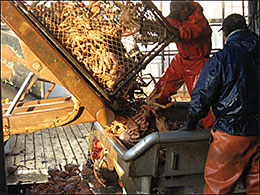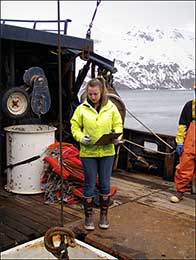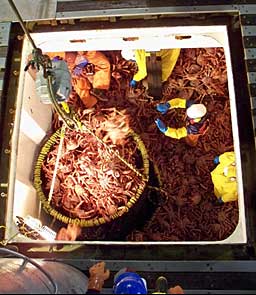Alaska Fish & Wildlife News
April 2013
Observers in the Aleutian Islands
Golden King Crab Fishery

Fishery
Golden king crab Lithodes aequispinus are a deepwater relative of the better known red king crab Paralithodes camtschaticus. Their most important commercial fishing grounds are in the Aleutian Islands, with smaller fisheries in Southeast Alaska and the Bering Sea. Aleutian Islands golden king crab fetched $3 to $4 per pound and produced a whopping harvest of 6 million pounds during the 2010 season.
The great depths (300–2,400 feet) and steep bottom topography of the inter-island passes inhabited by Aleutian Islands golden king crab necessitate fishing the crab pots on longline gear. Longlined pot strings include 10 or more pots at 60-foot intervals with heavier ‘anchor pots’ and a cluster of four buoys at each end. Longlining pots helps gear remain where set and saves time by minimizing the volume of buoy line that has to be set and hauled in deep, turbulent waters and also reduces time spent contending with sunken buoys. Even carefully set strings of longlined pots routinely have buoys sucked under by strong currents, and in some areas buoys are up only when the tidal current slows. Single pots are set in the more protected waters of Southeast Alaska.
The rectangular pots weigh up to 1,000 pounds with height and width measuring from five to ten feet on a side. All pots are equipped with escape rings or escape mesh to allow undersize crab, small female crab, and small bycatch species to escape. Pots are also required to have an 18-inch opening in the pot webbing that is laced with biodegradable twine designed to rot in case the pot is lost.
The Aleutian Islands golden king crab fishery has never failed to open due to low stock abundance, making it unique among the Westward Region king crab fisheries. The fishery was rationalized in 2005 by the North Pacific Fishery Management Council. Rationalization means that a limited number of participating vessels are each allotted an annual share of the harvest goal. Rationalization has improved safety and manageability of the golden king crab fishery, allowing vessels to fish from August 15 through May 15. In practice, the entire quota is generally caught by April. Because of their more southerly location and distance from the continent, the weather is less seasonally variable in the Aleutian Islands than the adjacent Bering Sea.
Life History
The rugged, steep topography of the golden king crabs’ deep-water habitat has made them difficult to study. Due in large part to the dedication of onboard crab observers, much information has been gained about the fishery’s characteristics and associated marine life. Like many deepwater species, this crab has little seasonality in its life history. Soft-shelled crab and crab with eyed eggs near hatching can be found throughout the year; their reproductive cycle is thought to be two years long. Because of the relatively stable environment in the depths where these crab live, there are no clear seasonal changes that necessitate synchronized molting and mating events.
Golden king crab also differ from red king crab in their reproductive strategy. They produce larger yolk-rich eggs and their larvae do not eat but develop by utilizing their yolk sac at depth, unlike other crab species whose larvae must feed on plankton in predator-rich surface waters.
With its powerful chelipeds, the golden king crab feeds on clams, mussels, barnacles, sea stars, sea urchins, snails, fish carcasses, worms, and other crustaceans. As with most crab species, golden king crab segregate by size and sex for much of the year. The steep topography of the rocky areas they inhabit may make this more marked for this crab species.
A Day in the Life of a Golden King Crab Fishery Observer
It’s the beginning of December, the week after Thanksgiving. I’ve been out in the Aleutian Islands observing on this golden king crab commercial fishing boat for a month already; hard to believe. We had a huge feast last week in honor of T-day. I’ll be done with this deployment by Christmas and another observer will take over on the boat after the holidays. My next observer gig will be Bering Sea snow crab. But back to the present , where my days are beginning to blend together.
At 23:30 yesterday I finished my last sample pot of the day. Right now it’s one minute past midnight and I just signaled the captain from my station on deck that I will sample the next pot. This will be my first pot of the day. The vessel is nearing the end of the last longline haul ‘til we break. Weather has come up a bit. It is pitch dark with heavy clouds and sleet blowing sideways in a 50-knot wind. Around us, waves are 20 feet high and building. The captain says it’s supposed to warm up and calm down.

00:10: A 7-foot square pot breaks the surface and there are crab to the tunnels! After checking the biotwine and escapement mechanisms and recording the buoy number, I grab my five sampling totes and line them up under the pot as the launcher lifts it to dump the contents. Next I slide the totes back to my sampling area and tie them to the seawall rail. A couple of the crew help––thanks guys! I find my seat, a five-gallon bucket, near the bait station, move it to my station then settle in, bracing my feet on the deck boards for balance. I start measuring and identifying everything in my totes. Spray hits my face regularly and water is dripping off the calipers as I measure crab and yell information into my recorder over the noise of the hydraulics. In order, I clearly state the species, sex, shell condition, carapace length, legal status, and anything else notable about each crab. The pot has 46 golden king crab, two sculpins, one sablefish, four basket stars and three snails.
00:58: I’m done and I pass the totes of crab back to the crew to retain or discard at their discretion. It’s time to head inside to transcribe the information from my recorder onto the data forms as the crew sets the line back. Just as I complete the forms, the crew comes in off deck. We have a snack and chat briefly. I hit the rack at 03:00. Waves rock me into a deep sleep and I dream about king crab moving en-masse back and forth on deck.
09:00: The captain switches on the light in our crew quarters, “Two miles to the gear!” One of my roommates requests breakfast in bed from the others and ends up with a face full of dirty socks. We start moving. I let the crew get ready first. Heading out a few minutes later, I am on the deck right after they finish hauling the seventh pot on the longline string. I signal the captain that I’ll sample the next pot that comes up.
09:45: It won’t be light for another hour. Still cloudy but no precipitation and the water is calmer. A five-foot square pot breaks the surface. This will be sample number two. Not much in this one: 20 crab, mostly keepers. I snicker as the greenhorn runs by…they clipped a tail on him again. Wonder how long it’ll take him to notice? I quickly check the back of my raincoat, and I’m wearing one too. I’ll leave it there for the rest of this string; it’s been a long trip and we could all use a few extra laughs. I clean and organize my sampling area between a few pots then signal the captain that I’ll sample the next one.
10:25: Sample number three for today. Another ‘five by’ breaks the water. Not many crab, so after a few minutes of sampling I go up to the wheelhouse for yesterday’s fishing information. The captain gives me pot locations from his navigational computer and catch, effort, and location information from his logbook. Done with that, I head to the galley table to do paperwork. The vessel finishes pulling that string and then resets the longline of 48 pots.
Running to the next set of gear the captain exclaims, “Time for breakfast!” At noon, we gather around the table loaded with scrambled eggs, bacon, sausage, pancakes, hash browns, and biscuits and gravy. They must not be too hungry today. The galley is chock full of aroma. Fresh coffee too! With full stomachs we clean the kitchen and captain shouts down from the wheel house, “Half mile to the gear!”
Crew heads out. I finish the dishes then head outside too. We wait on deck for about half an hour watching for buoys and the captain finally declares, “Bags are down (underwater). We’re running to the other end of the string.” The crew heads inside and a couple of them curl up on the floor of the companionway for a quick nap in their raingear. I decide to climb up on the foredeck. The weather is calm. Clouds are thinning, showing a miraculous patch or two of blue sky. I see an adult Short-tailed Albatross and make a note to myself to fill out a US Fish and Wildlife Service bird-sighting form in my logbook. This makes the second sighting on this deployment.

14:00: Captain calls out “Bags on the bow!” I signal to sample the next pot at 14:15, then another at 15:00. There are 19 and 25 keepers respectively and no bycatch in sample pot numbers four and five.
15:40: I head inside to have a cup of coffee and do paperwork while the gear is reset. Hmmm, only enough left for one cup. I will not be the one to coffee-foul, so I step back out and ask the crew if they’d like another pot made right now or if they’re done for a while.
15:50: Captain calls out, “Four-hour steam to the next set of gear.” He says we’re headed to a small island west of here across the 180° line. I make a mental note to write East instead of West longitude for the next sample pot locations. I finish my paperwork while the crew does deck chores. The crew starts to filter in as I’m completing my last form. We grab a snack then use the time to rest, read, and watch a movie.
20:00: Captain hails, “Two miles to the gear!” Everyone downs a mug of coffee. We gear up in our Hellys and head to the deck to prepare for the next string.
2055: I signal my next sample pot and a five by comes up. Sample number six has 50 keepers, eight sublegals just under legal size, and two good-sized females with eggs. Some sponges were present.
22:00: I signal for my last sample of the day. Weather is still decent. The pot held 33 legals, one with a parasitic barnacle egg sack on its abdomen.
22:35: I stack and secure my sampling totes and bucket to the rail for the night. Ahhhh, done on deck early today! The crew is resetting gear and the cook is in the galley. I spend a few minutes helping him chop vegetables and then take about an hour to complete my paperwork. When dinner looks close, I clean all my paperwork out of the galley and help set the table. Dinner is served at midnight. Seas came down enough to allow a pot roast to stay in the oven all day. On the table with the roast is a large pot of freshly mashed potatoes, hot dinner rolls, coleslaw, a couple of pitchers of Kool-Aid and iced tea. We grab a few gallons of our favorite ice cream from the freezer to finish off, and then clean the galley.
01:00: It’s time to hit the rack. Captain says they’re hauling four strings tomorrow, “Plan to get going at 08:00.” Wow, seven hours of sleep tonight. We could get spoiled!
Observer Program Findings
Because of the challenging fishing conditions, stock assessment pot surveys for Aleutian Islands golden king crab are expensive and surveys are conducted, at most, every third year. Thus, the information collected each season by onboard observers, such as catch rates and size distribution, is a vitally important data source. Observers are also essential in facilitating tag recoveries. A stock assessment model is currently under development.
Information emerging on golden king crab life history and habitat, as well as fishing gear and methods, helps managers better understand this enigmatic species and sustain the fishery. For example, data collected by observers has shown that males mature at a smaller size in more northerly latitudes, and has allowed managers to develop geographically-appropriate size limits for this species. Another outcome of observer-collected data is an understanding of the impacts of fisheries rationalization. There fishing competition characteristic of the once over-capitalized fishery is gone. This has resulted in increased soak times for fishing gear, reducing sublegal bycatch levels and allowing fishermen the opportunity to better target areas where legal-sized crab are found. Finally, observer descriptions of bycatch have begun to paint a broad picture of the ecosystem inhabited by this species; the ecosystem that is key for a sustained fishery in the future.
For more on the observer program see the video, Observers in the Bering Sea and Aleutian Islands Crab Fisheries.
Subscribe to be notified about new issues
Receive a monthly notice about new issues and articles.
